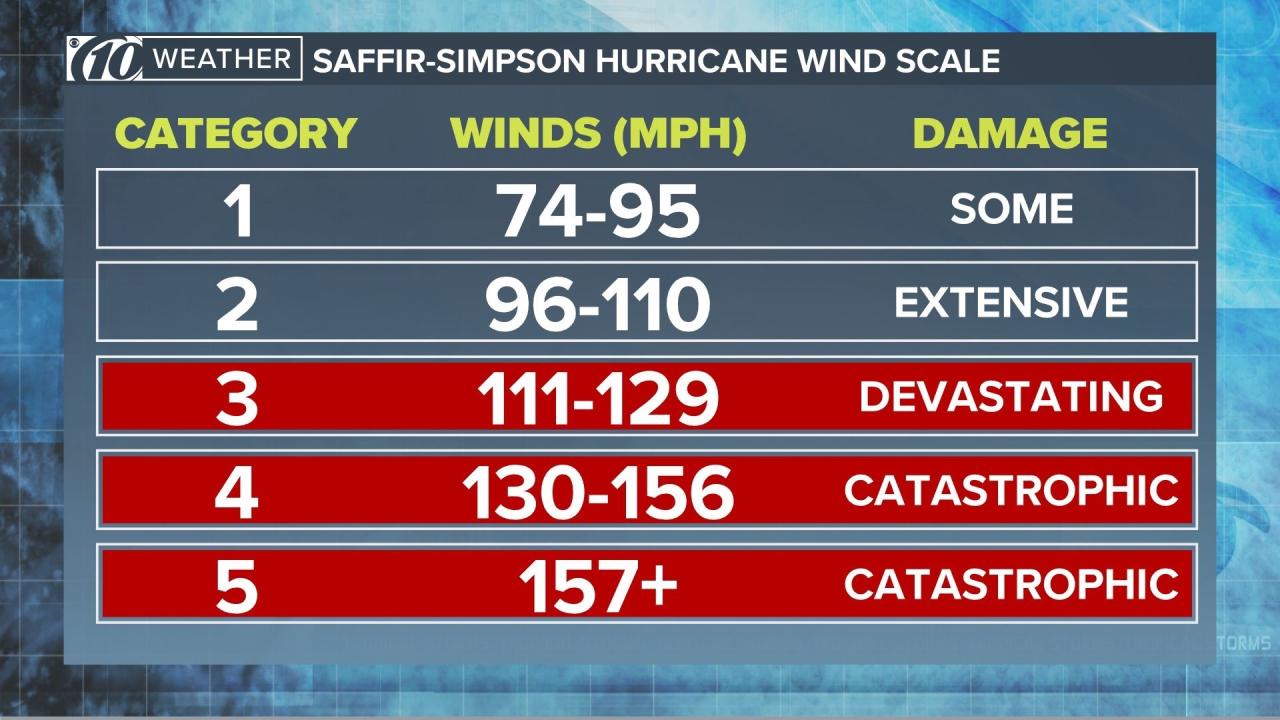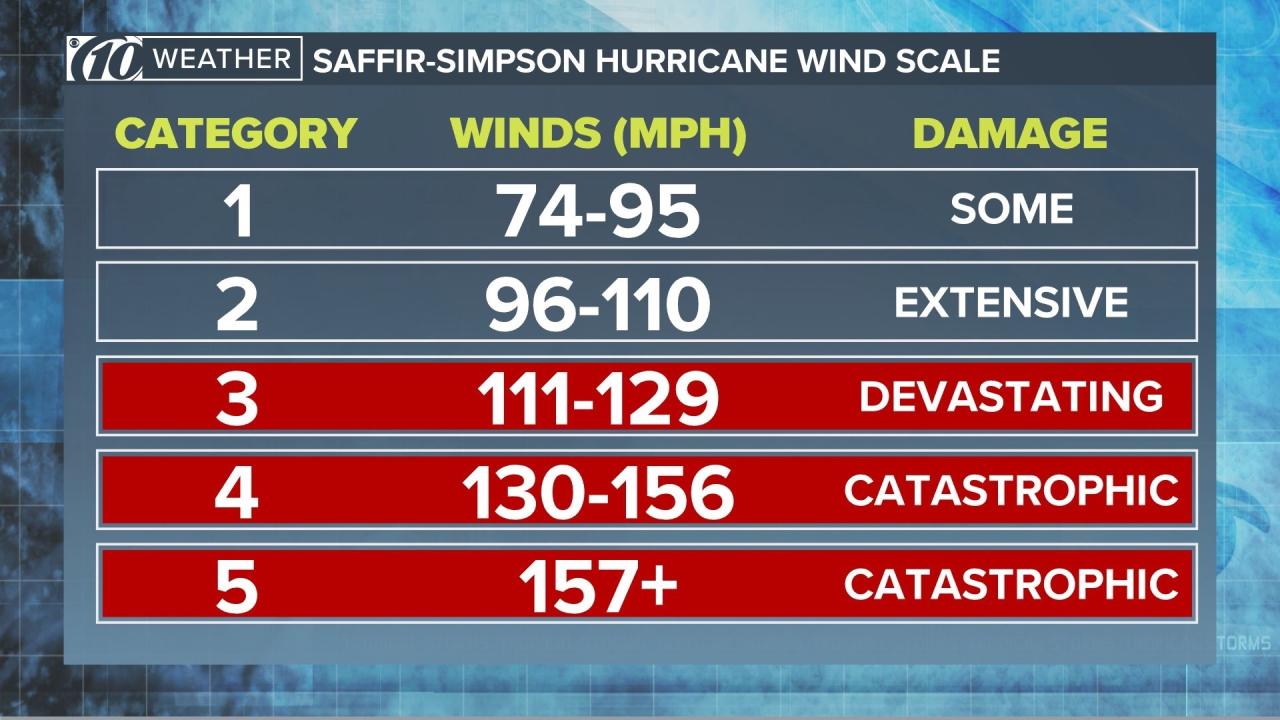Unveiling the destructive power of Cat 4 hurricane wind speed, we embark on a journey to understand its impact, potential dangers, and strategies for mitigation. Brace yourselves as we delve into the heart of this meteorological phenomenon, exploring its devastating force and the measures we can take to protect ourselves and our communities.
Cat 4 hurricane winds, characterized by sustained speeds ranging from 130 to 156 miles per hour, possess the capacity to inflict widespread devastation. Understanding their potential impact is crucial for effective preparation and response.
Hurricane Wind Speed and Categories
Hurricanes are classified into categories based on their maximum sustained wind speed. The Saffir-Simpson Hurricane Wind Scale is a 1-to-5 rating system that estimates potential property damage. This scale was developed by Herbert Saffir and Robert Simpson in 1973 and has been used by the National Hurricane Center since 1975.
Wind Speed Ranges for Hurricane Categories, Cat 4 hurricane wind speed
| Category | Wind Speed (mph) |
|---|---|
| 1 | 74-95 |
| 2 | 96-110 |
| 3 | 111-129 |
| 4 | 130-156 |
| 5 | 157+ |
Relationship Between Wind Speed and Potential Damage
The higher the wind speed, the greater the potential for damage. Category 1 hurricanes can cause some damage to trees and power lines, while Category 5 hurricanes can cause catastrophic damage to buildings and infrastructure. The following table provides examples of potential damage for each hurricane category:
| Category | Potential Damage |
|---|---|
| 1 | Damage to trees and power lines |
| 2 | Damage to roofs and windows |
| 3 | Damage to buildings and infrastructure |
| 4 | Catastrophic damage to buildings and infrastructure |
| 5 | Widespread devastation |
Impacts of Cat 4 Hurricane Winds

Category 4 hurricane winds are capable of causing widespread and catastrophic damage. The destructive power of these winds can result in severe structural damage to buildings, infrastructure, and natural environments.
Structural Damage
Cat 4 hurricane winds can exert immense pressure on structures, causing them to collapse or sustain severe damage. Roofs can be torn off, walls can be blown out, and windows can shatter, leaving buildings vulnerable to further damage from rain, wind, and debris.
Infrastructure Impacts
Hurricane winds can also wreak havoc on infrastructure, including power lines, communication networks, and transportation systems. Power outages can occur due to downed power lines, leaving communities without electricity for extended periods. Communication networks can also be disrupted, making it difficult for people to stay informed and connected.
Risks to Human Life and Property
The high winds associated with Cat 4 hurricanes pose significant risks to human life and property. Flying debris can cause injuries or fatalities, and downed trees and power lines can create hazardous conditions. Buildings that collapse or sustain severe damage can trap or injure occupants.
Preparation and Mitigation Strategies: Cat 4 Hurricane Wind Speed
Preparing for and mitigating the effects of Cat 4 hurricane winds is crucial to protect lives and property. Implementing proactive measures can significantly reduce the potential damage and ensure the safety of individuals and communities.
Securing Loose Objects and Reinforcing Structures
Securing loose objects outdoors and reinforcing structures are essential steps in hurricane preparedness. Unsecured items, such as patio furniture, grills, and trampolines, can become dangerous projectiles in high winds, causing significant damage to buildings and infrastructure. Reinforcing windows and doors with storm shutters or plywood can prevent shattering and protect interiors from wind-driven debris.
Evacuation Plans and Emergency Shelters
Developing evacuation plans and identifying emergency shelters are critical for protecting people from hurricane winds. Evacuating to designated shelters or safer locations when instructed by authorities is essential for those in high-risk areas. Emergency shelters provide temporary refuge and essential services, such as food, water, and medical assistance, during and after the storm.
Last Recap
In conclusion, Cat 4 hurricane wind speed poses a significant threat to human life and infrastructure. By understanding the potential impacts, implementing mitigation strategies, and adhering to evacuation plans, we can enhance our resilience and minimize the devastation caused by these powerful storms.
FAQ Corner
What are the potential structural damages caused by Cat 4 hurricane winds?
Cat 4 hurricane winds can cause severe structural damage to buildings, including roof damage, shattered windows, and even complete destruction in some cases.
How do Cat 4 hurricane winds affect infrastructure?
These winds can topple power lines, disrupt communication networks, and damage transportation systems, leading to widespread outages and disruptions.
What are the risks to human life posed by Cat 4 hurricane winds?
High-speed winds can cause severe injuries or even death due to flying debris, collapsing structures, or downed power lines.

